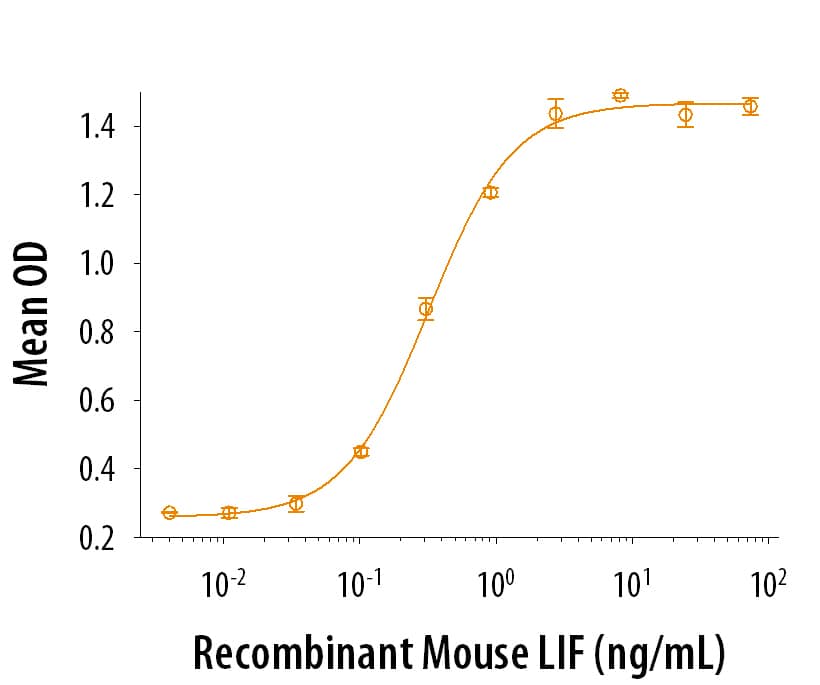Recombinant Mouse LIF Protein
R&D Systems, part of Bio-Techne | Catalog # 8878-LF

Key Product Details
Product Specifications
Source
Pro25-Phe203
Purity
Endotoxin Level
N-terminal Sequence Analysis
Predicted Molecular Mass
SDS-PAGE
Activity
The ED50 for this effect is 0.1-0.6 ng/mL.
Scientific Data Images for Recombinant Mouse LIF Protein
Recombinant Mouse LIF Promotes the Expansion of Mouse Embryonic Stem Cells.
Recombinant Mouse LIF Promotes the Expansion of Mouse Embryonic Stem Cells. D3 mouse ESCs were cultured with Recombinant Mouse LIF (10 ng/mL). After 15 days, and following multiple rounds of passaging, the ESCs were analyzed for pluripotency by staining with PE-conjugated Mouse Anti-Human/Mouse SSEA-1 PE-conjugated Monoclonal Antibody (Catalog # FAB2155P) and APC-conjugated Mouse Anti-Human/Mouse SSEA-4 APC-conjugated Monoclonal Antibody (Catalog # FAB1435A). ESCs continue to express the pluripotency marker SSEA-1 and lack expression of SSEA-4, a negative marker for mouse ESCs. Quadrants were set based on samples stained with isotype control antibodies.Mouse Embryonic Stem Cells Cultured in Recombinant Mouse LIF Maintain their Pluripotency.
Mouse Embryonic Stem Cells Cultured in Recombinant Mouse LIF Maintain their Pluripotency. D3 mouse ESCs were cultured in Recombinant Mouse LIF (10 ng/mL) for 15 days, including 4 passages. ESCs continue to express the mouse pluripotency markers, SSEA-1 (red) and SOX2 (green). SSEA-1 was visualized with the Human/Mouse SSEA-1 NorthernLights™ (NL)557-conjugated Antibody. SOX2 was visualized with the Goat Anti-Human SOX2 Antigen Affinity-purified Polyclonal Antibody (Catalog # AF2018) followed by the Donkey Anti-Goat IgG NorthernLights™ NL493-conjugated Polyclonal Antibody (Catalog # NL003). The cell nuclei were stained with DAPI (blue).Recombinant Mouse LIF Stimulates IL-6 Secretion.
Recombinant Mouse LIF Stimulates IL-6 Secretion. Recombinant Mouse LIF (Catalog # 8878-LF) induces IL-6 secretion in M1 mouse myeloid leukemia cells. The ED50 for for this effect is 0.1-0.6 ng/mLFormulation, Preparation and Storage
Carrier Free
What does CF mean?CF stands for Carrier Free (CF). We typically add Bovine Serum Albumin (BSA) as a carrier protein to our recombinant proteins. Adding a carrier protein enhances protein stability, increases shelf-life, and allows the recombinant protein to be stored at a more dilute concentration. The carrier free version does not contain BSA.
What formulation is right for me?In general, we advise purchasing the recombinant protein with BSA for use in cell or tissue culture, or as an ELISA standard. In contrast, the carrier free protein is recommended for applications, in which the presence of BSA could interfere.
Carrier: 8878-LF
| Formulation | Lyophilized from a 0.2 μm filtered solution in PBS with BSA as a carrier protein. |
| Reconstitution | Reconstitute at 0.2-1 mg/mL in sterile PBS. |
| Shipping | The product is shipped at ambient temperature. Upon receipt, store it immediately at the temperature recommended below. |
| Stability & Storage | Use a manual defrost freezer and avoid repeated freeze-thaw cycles.
|
Carrier Free: 8878-LF/CF
| Formulation | Lyophilized from a 0.2 μm filtered solution in PBS. |
| Reconstitution | Reconstitute at 0.2-1 mg/mL in sterile PBS. |
| Shipping | The product is shipped at ambient temperature. Upon receipt, store it immediately at the temperature recommended below. |
| Stability & Storage | Use a manual defrost freezer and avoid repeated freeze-thaw cycles.
|
Background: LIF
References
- Moreau, J.F. et al. (1988) Nature 336:690.
- Trouillas, M. et al. (2009) Eur. Cytokine Netw. 20:51.
- Metcalfe, S.M. (2011) Genes Immun. 12:157.
- Gearing, D.P. et al. (1987) EMBO J. 6:3995.
- Cheng, J.G. et al. (2001) Proc. Natl. Acad. Sci. USA 98:8680.
- Tomida, M. et al. (1993) FEBS lett. 334:193.
- Paiva, P. et al. (2009) Cytokine Growth Factor Rev. 20:319.
- Slaets, H. et al. (2010) Trends Mol. Med. 16:493.
- Bamberger, A.M. et al. (2000) Mol. Cell. Endocrinol. 162:145.
- Kamohara, H. et al. (2007) Int. J. Oncol. 30:977.
- Duluc, D. et al. (2007) Blood 110:4319.
- Zouein, F.A. et al. (2013) Eur. Cytokine Netw. 24:11.
Long Name
Alternate Names
Gene Symbol
UniProt
Additional LIF Products
Product Documents for Recombinant Mouse LIF Protein
Product Specific Notices for Recombinant Mouse LIF Protein
For research use only


